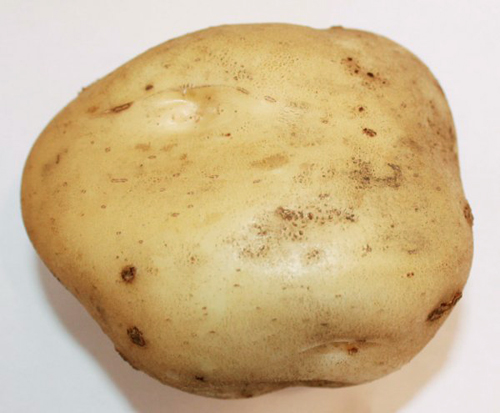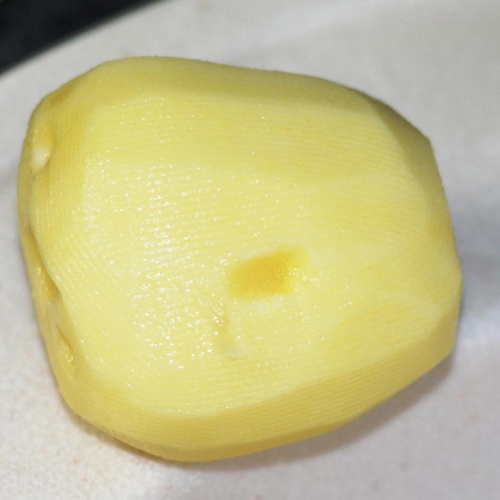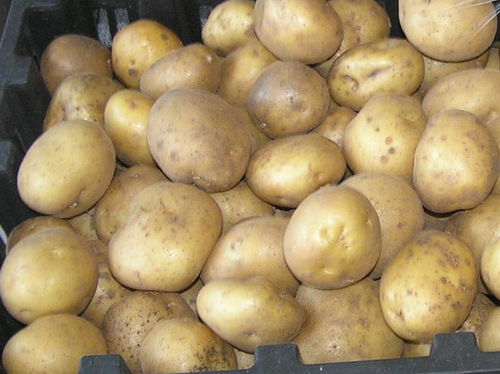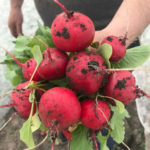Potato variety Timo Hankkiyan
Timo is an early ripening potato variety (Solanum tuberosum). Bred in Finland by Boreal plant breeding LTD specialists. In 1999 he was included in the state register of breeding achievements of the Russian Federation under the official name "Timo Khankkiyan". Approved for cultivation in three regions of the country: North-West, Volgo-Vyatka and Central. It has a table purpose, is versatile in cooking, and has a good taste. Suitable for growing in northern latitudes.

The period from emergence to ripening is about 50-65 days, the first digging can be carried out on the 45th day of the growing season.
The plant is low, spreading, and at the same time very compact. The leaves are very large, from closed to intermediate type, light green, sometimes darker. The leaf is large, narrow or medium wide, the upper side is glossy. Potato inflorescences are small, corollas are very small, bluish-purple in color.
In one nest, 5-9 massive tubers weighing 65-120 grams can be formed. They have an oval-rounded shape, often irregular. The rind is thin, yellow in color, smooth to the touch. The pulp is light yellow in color. The eyes are shallow, the depth is average.
Yield indicators of Timo vary depending on the region of growth. So, according to state tests, in the Northern region, the marketable yield was recorded in the range of 150-233 c / ha, at the level of standards for the varieties Izora, Pushkinets. The maximum amount was harvested in the Republic of Karelia - 282 c / ha, 42 c / ha higher than the results of Izor. When digging on the 50th day of vegetation in the Arkhangelsk region, 218 c / ha were obtained, 36 c / ha more than the Pushkinets standard. In the North-West region, the marketable yield was 234-382 c / ha, 70-89 c / ha higher than the standards of Pushkinets and Izora. In the Leningrad Region, during the first digging (on the 45th day of the growing season), it was possible to collect 237 c / ha, 79 c / ha more than Pushkinets indicators, and after the second digging (on the 55th day), 286 c / ha were obtained, on 82 kg / ha is higher than the standard. The maximum yield in this region was noted in the Kostroma region - 382 c / ha, 89 c / ha more than the Izor standards. In the Central region, Timo's marketable yield varies within 170-211 c / ha, 55-125 c / ha higher than the results of Bryansk Early and Zhukovsky Early. In the Bryansk region, after the first digging, it was possible to get 88 c / ha, at the level of the Bryansk early standard, and after the second - 298 c / ha, 60 c / ha higher than the established standards. The maximum amount of harvested potatoes in this area was recorded at around 303 c / ha, 69 c / ha more than Bryansky Early.
The marketability of tubers varies from 69 to 91%, at the level and 13% higher than the Zhukovsky early standard. It is worth saying that this indicator is highly dependent on the region of growth, the type of soil and agricultural technology. Keeping quality is excellent - 96%.

Timo's taste is very good. The tubers are medium-sized, versatile in cooking, suitable for cooking any dishes. Best suited for frying, including deep-fried, boiling, stuffing, baking, as well as for making mashed potatoes, soups, mixed vegetables and salads. The pulp does not darken during cutting and heat treatment, in the finished form it is moderately crumbly, with a pleasant texture. The starch content is 13.4-14.2%, at the level of the Bryansk Early and Izora standards.
The variety is very simple in agricultural technology, and also undemanding to soil and climate. It is excellent for cultivation in northern regions. However, it is worth noting one caveat - plants very painfully tolerate sudden temperature changes, especially cold snaps. Therefore, in areas with an unstable climate, yields can vary greatly in different seasons. In care, potatoes are unpretentious, but they respond very well to some agrotechnical subtleties. Below is a short list of tips for growing.
- Before planting, tubers must be selected and calibrated. It is also advisable to treat them with disinfectants against diseases and pests; you can also use growth stimulants.
- Planting is carried out only after the soil warms up to + 10−12 ° С. After this moment, there is no need to be afraid of recurrent frosts.
- The planting depth of Timo's seed is 6-8 cm on light soils, on heavy soils - no more than 5 cm.The distance between the holes should be about 35 cm, the row spacing should be 60 cm.
- Plants respond well to feeding. Before flowering, organic fertilizers can be used, however, from the moment the buds appear, their application must be limited or stopped altogether so that the growth of tops does not intensify to the detriment of the tubers. But mineral complexes can be added throughout the growing season as needed.
- Do not forget about other agrotechnical measures. Watering, weeding, hilling, soil loosening, treatment against pests and diseases. All this will have a good effect on the yield.

- Maintain crop rotation. Timo has a low resistance to the causative agent of late blight, but the tubers ripen before it appears. But if you plant in contaminated soil, then you can clearly not count on a good healthy harvest. Therefore, you should not plant potatoes in an area where other nightshade crops grew before it. It is best to use the soil after legumes, green manures, cabbage, beets, cucumbers, zucchini, onions, and garlic.
- Update your seed in a timely manner. Without this important event, tubers with "age" will begin to shrink and acquire ugly shapes.
Plants have a rather low resistance to golden cyst nematodes and scab, as well as late blight, as mentioned above. They show moderate resistance to various viruses. Vulnerability to diseases is one of the main disadvantages of the variety, therefore, with the appearance on the market of various highly disease-resistant varieties, our hero began to lose his popularity among gardeners and large agricultural enterprises.
But still, despite this rather large minus, potato growers have continued to grow Timo for many years. They do not want to give it up because of its very good taste, early amicable ripening of tubers, excellent keeping quality. Also, the formation of the crop before the appearance of late blight deserves attention.
We will also mention a few more disadvantages. According to the observations of gardeners, our hero is not reliable. In the worst seasons, you run the risk of being left without a crop altogether. The variety, in addition to weak resistance to diseases, is often affected by pests, the first among other varieties on the site. There are also negative reviews about the yield and later ripening of potatoes than the originator claims. However, I would like to note that these indicators are highly dependent on the climatic zone of growth and weather conditions of the season.








